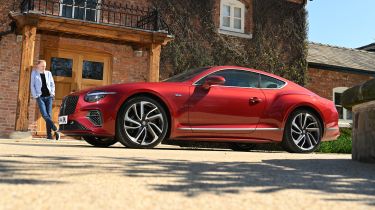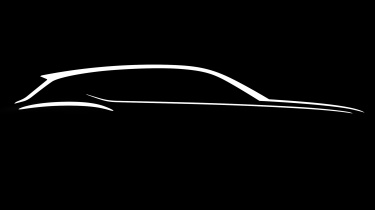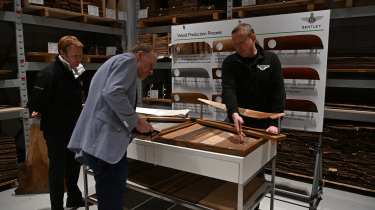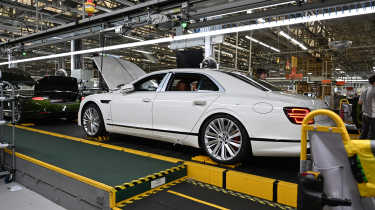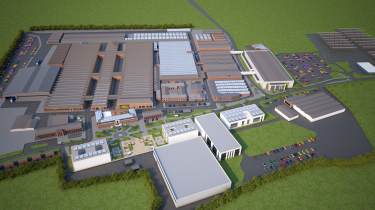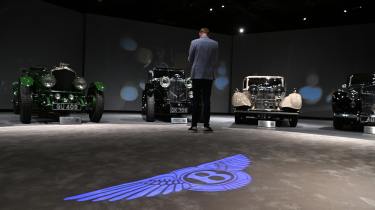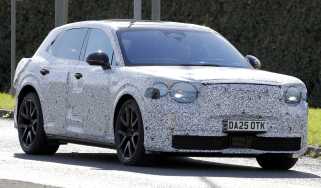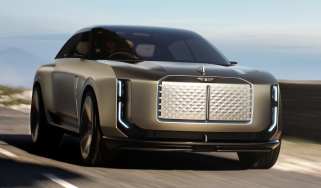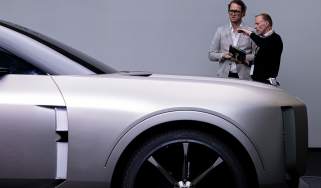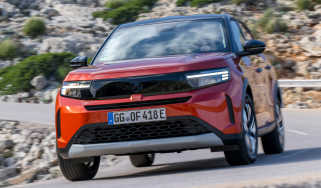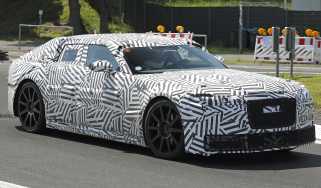Bentley electric car: exclusive new details on the brand's first EV
Auto Express is the first inside Crewe’s new Dream Factory, which starts its pilot build of the electric Urban SUV within weeks
The Continental GT is a Speed First Edition and we’re certainly closing fast on Bentley’s Crewe factory. Leafy green hedges pass in a blur and the body feels nicely tied down even when charging over humpback bridges, yet the engine tacho is pinned at zero revs. Witchcraft? The faint electric whine gives up our secret: like all Continental GTs, this is a plug-in hybrid, one easily capable of 60mph without the V8 barking into life.
This part-electrified Conti is a mere appetiser for what we’re about to see, as we become the first people outside Bentley to set foot inside its brand- new, three-billion-plus-Euro electrified car factory.
Deep in the new campus, engineers are busily installing equipment enabling prototype production of Bentley’s first BEV (battery-electric vehicle), which will start just eight weeks from now.
Referred to as the ‘Luxury Urban SUV’, the BEV will be a little shorter than today’s models, wear an imposing body immediately recognisable as a Bentley and be luxuriously trimmed by the company’s artisans. But their work will incorporate new hi-tech materials and cutting-edge ways of working, including AI and Autonomous Guided Vehicles to transport the car bodies.
This is the perfect distillation of Bentley’s vision for its ‘Dream Factory’, a place where heritage and modernity intersect. And where a cutting-edge electric-vehicle line lurks within the site’s oldest building, A1, constructed in 1938 to build Merlin aero engines with World War II looming.
Andreas Lehe, Bentley’s towering board member for manufacturing, meets us at the end of today’s Continental and Flying Spur assembly line to share the company’s vision. “It might have been easier to knock down all the old buildings and build them new,” he says. “But it was important for us to secure these old buildings and integrate new technology and cars into this heritage.”
To meet him, we’ve rushed through the existing wood shop, trim shop and final assembly, but along the way we’ve picked up some key insights into how the process is changing.
Bentleys are famed for their wood veneer trims, six paper-thin layers currently mounted and baked onto aluminium substrates. Three new injection-moulding machines stand to the side, ready to create different-sized substrates for the new BEV. They’ll be made of plastic, to save a little weigh and boost sustainability; they should come from recycled sources and be reused at the end of life.
And because they’re opaque, Bentley could backlight the trim according to customer tastes. Instantly it paints a picture of a BEV cockpit with a deep-rooted, delightful but hi-tech ambience. Apprentices are already being trained to master the injection-moulding process in pre-production phases, so the quality will be top notch by 2027, when series production is in full flow.
We discover the trim shop harbours similar modernisation when we walk the shop floor, as 50 customers do each month. While many still favour leather and wood, some already choose sustainable microfibre ‘Dinamica’, and Bentley is experimenting with upholstery made with squashed and pressed bamboo for the Urban SUV.
I also spy a black box casting infra-red light as it moves over a leather hide. This is a Homiro scanner, which uses AI to spot imperfections and can outperform the human eye – just like software trained to diagnose skin cancers. I’m not sure whether to be awe-struck or fearful for the job implications, a trend far from restricted to the car industry. I’m partially reassured by a new sewing line in construction at the building’s end, with a good old-fashioned café area proving the workers will be humans not robots.
Production director Andy Hobbs then sweeps us along the straight GT line, where 96 stations all running to a strict 10-minute schedule finish the painted bodies-in-white. The bigger Bentayga SUV– on a separate line – has fewer stages, but with more than twice the time taken at each.
The electric future will be far less rigid, as Andreas Lehe explains. Block A1 covers a vast 30,000 square metres and, when Bentley’s electric transformation is complete after 2035, should be home to five model lines under one roof.
It’s an assembly line where Autonomous Guided Vehicles (AGVs) will tow bodyshells from one assembly station to the next, on circuitous routes not unyielding lines. That allows Lehe and his team to plan assembly in ‘S’ configurations, leaving plenty of space for preparation areas and storage racks. It is extremely adaptable.
“If you combine all cars in one line, you get more or less stable production over the whole time, because when one car is running down, another is increasing,” says the manufacturing chief.
“Our general plan is to integrate all the cars in this new line, step by step, car by car. If you have three lines running in parallel, you always have to ask ‘what’s the volume, [how many] people, what’s the impact?’ It’s much better to balance this in one assembly [line] in future.”
This is the four-dimensional chess played by Lehe and his predecessor Peter Bosch, as they remake Crewe for the future. I’m told there’s a big floor mat of the site, covered in Velcro pieces representing each of the buildings to scale. Executives stand around and discuss moves, seeing at a glance the impact on site production flow. “[Site planning] is definitely like a jigsaw puzzle,” agrees Lehe.
The AGVs can be programmed to follow any route and they’ll lift Urban SUV bodies up and down by responding to digital signals identifying an assembly stage or even individual workers. Such pinpoint ergonomics should help prevent injuries. Digitalisation will also put an end to each car’s identifying spec being printed on low-tech paper taped to it: each car will have digital identifiers, allowing the tooling to be automatically set to the correct torque levels or assembly patterns.
But what will they be assembling, what defines an electric Bentley? “Ultimately, the drivetrain is not the most important part for the customer,” responds Lehe. An EV’s huge torque and superior refinement will be trademark Bentley, but the manufacturing boss believes the key thing will be to offer sufficient range and convenience.
“You don't need an 800-mile range! I think 350 to 400 miles and charging stations available to charge fast. Bentley customers don’t want to wait.”
A knockout cabin will also be crucial. “Interior is one of the areas which is important for us as Bentley. From a quality perspective, I think we offer one of the best luxury-car interiors. And we want to secure this real craftsmanship into the future.”
The Urban SUV is based on the Volkswagen Group’s PPE (Premium Platform Electric) architecture, which also underpins the Porsche Macan Electric and Audi Q6 e-tron. It will get their air suspension and rear-wheel steering, boosting manoeuvrability for its urban habitat.
Know-how is also shared across the group brands: Lehe’s manufacturing team meet their Audi counterparts monthly to ensure the electronic architecture is running smoothly. Software can make or break a new car: the Macan and Q6 were more than a year late because of issues at VW’s programming arm, Cariad.
We head out to see the new buildings in a redevelopment that began five years ago when Pyms Lane, the public road through the site, was closed after a lengthy consultation. Our guide is head of site planning Andrew Robertson, who joined in 1999 to install the first Continental GT line.
He drives us in an electric vehicle – sadly not the Urban SUV, but a golf kart. First, we trundle down Sunnybank Road between the two paint shops. To our right is the huge new facility, a vast white rectangle 22 metres high. Set to paint its first car in October, the hi-tech shop will allow a broader array of colours and finishes (including two-tone and pinstriping), and slash energy consumption with a low-bake process at half the 160˚C norm.
A catalyser in the chimney will stop any solvents escaping into the atmosphere.
Crewe became carbon neutral in 2019, thanks to 46,000 solar panels mounted on roofs that generate 10 megawatts on a sunny day and also by buying green energy and gas.
Linked by an air bridge to move materials, the current, near 50-year-old paint shop stands on the opposite side of the road. This will be decommissioned once the new facility is perfectly painting the BEV, becoming a storage area for bodies-in-white shipped in from Volkswagen factories in mainland Europe.
Next stop is the Integrated Logistics Centre, where construction workers suspended in the air busily enclose a side. It looks colossal but is actually less than half the size of the BEV building it neighbours for speedy supply.
Taking inspiration from Amazon warehouses, ‘autopickers’ will whizz along rails in the ceiling before descending into columns to grab crates of parts. Again, the whole thing will be fully digital and supersede the existing store.
Good old-fashioned forklift trucks will be needed to shift the Urban SUV’s battery packs though. Imported from Bratislava, Slovakia, they weigh 570kg and harbour 95kWh of usable energy in the Macan; it remains to be seen if Bentley will expand on this.
Maybe we’ll find out in another inconspicuous, white building on the north-eastern corner of the site: the Engineering Technical Centre. “The new BEV is in there,” confirms Wayne Bruce, our PR minder. “And that’s why we’re not going in.” Sigh. Auto Express has already spied crude prototypes wearing a butchered Porsche Cayenne shell; the real body will venture out testing towards the year’s end. Meanwhile chassis development, electrical and trim engineers – “most disciplines”, reckons Robertson – are working their magic. “There’s a Bentley-fication process. We borrow group technology but make it ours,” says Bruce.
Appropriately, our tour culminates at the BEV assembly line. The surroundings feel similar to the other lines – no surprise given Bentley’s determination to preserve the original walls and roof. But the floor, marked with heavy plant tracks in the construction dust, is brand new.
“There’s a reason for that: the AGVs,” explains Robertson. “Carrying the cars will generate fairly high point loads. So this fibre-reinforced concrete is the flattest and strongest I’ve laid in my career.”
I peer down the 300-metre-long hall in the hope of finding out more, but can’t make out what equipment they’re fitting. I can certainly hear it, though: the sound of drilling shrieks in our ears.
How does this differ from the Continental GT line Robertson helped to fit 25 years ago? “The AGVs and the control systems,” he replies. Equipment will be wirelessly connected to the internet, enabling automated tool settings and pinpoint diagnostics and analytics.
We’ve seen the future of Crewe. Andreas Lehe reckons the transformation is the most ground-breaking development since Volkswagen bought Bentley in 1998. “For me, it’s at the very top,” he says. “And the most important part is to secure the future of Bentley.
“For 85 years, Crewe has been Bentley’s home. So it was clear to make this investment into Crewe. It's a commitment from our side to the region and to our heritage: for the next 100 years, we want to build all our cars in Crewe.”
Our dealer network has 1,000s of great value new cars in stock and available now right across the UK. Find your new car…
Find a car with the experts

